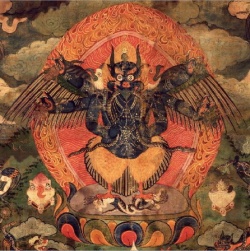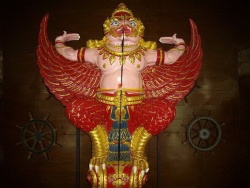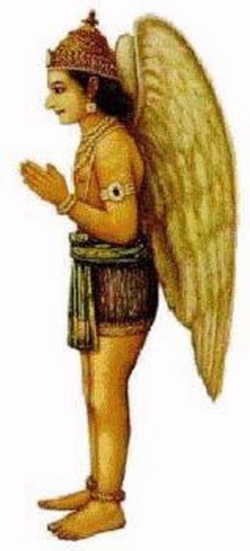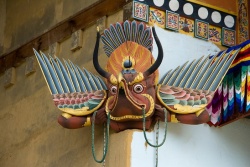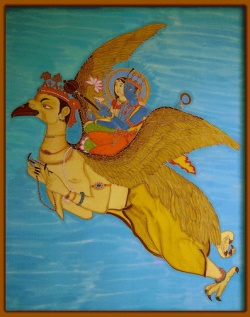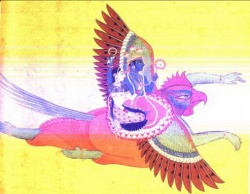Garuda and...
Garuda (Jap. Karura) is a mythological bird usually described as having a human form with the head of a bird. Created from the cosmic egg that also hatched the 8 elephants supporting the universe, he was fully mature when hatched.
Garuda can easily traverse the universe from end to end. It can kill and eat poisonous snakes with no harmful consequences to itself.
The oldest collection of Indian hymns, the Rig Veda says:
They call him Indra, Mitra, {{Wiki|Varuna]], Agni
And he is heavenly nobly-winged Garutman.
To what is One, sages give many a title;
They call it Agni, Yama, Matarishvan . . . . .
Garuda and the Sacred Kusha Grass
The Hindu epic, Mahabharata, tells of the connection between Garuda and sacred kusha grass [Poa cynosuroides,] the same kind of grass provided as a meditation seat for the Buddha.When Garuda brought some amrita from the moon for the Nagas as his mother's ransom, Indra tried to prevent it. The amrita would make the nagas immortal, and they would pose a threat to Indra's position as King of Heaven. But faithful Garuda would not compromise his mother's liberation. However, he arranged that after the nagas received it, it could then be stolen from them. In preparation for this, Garuda laid the nectar of immortality contained in its flask on the grass. That made it easy for Indra to steal which he did while the nagas were bathing in the stream.
When they emerged from the water, they expected the amrita to be on the kusha grass, itself. As they tried to lick up the divine substance, the spiky leaves of kusha slit their tongues. It is for this reason that the tongues of serpents are forked, and also that kusha [or kusa] is sacred -- for having been in contact with amrita.
Garuda and the Kumbh Mela
The Hindu festival, the Kumbhmela, is held at a different spot on the shores of the Ganges every 12 years. At the beginning of 2001, Allahabad was the focus for this largest of the world's gatherings. It is one of four spots where Garuda is believed to have rested during a battle with demons over the pot of divine nectar of immortality. Garuda's flight lasted 12 divine days, or 12 years of mortal time, so the Kumbh Mela is celebrated at each city of 3 towns, alternating among them every three years.
South IndiaAccording to South Indian legend, in Kanchipuram an ardent devotee of Lord Vishnu, who was a sculptor, carved a Garuda image out of wood. Having been correctly carved according to the Shilpa Shastras, the figure came to life. It flew into the air, heading towards the south. At the village of Parakkai, the Garudatook a dip in the tank in front of the temple there, exclaiming with delight. Then he rose again and hovered around the temple deity as if doing pradakshina (Tib. kora, devotional circling.)
An artisan working on a pillar at the temple saw the bird and for some reason, hurled his chisel at it hurting its right wing. The bird fell to earth crying, "Madhusudhana," to the man's disbelief. The famous 4-armed stone image of Vishnuwas later carved and installed on that spot.
In Nepal
Near Nagarkot in Nepal there is a Vishnu temple dating to the time of King Manadeva, who is also associated with the stupa of Bodhnath. In the courtyard is a pillar inscribed with one of the earliest histories of Nepal. The place is called Changu Narayana. Atop the pillar is a kneeling figure facing the shrine known as the Manadeva Garuda since the moustached face is believed to represent the king. Buddhists also worship at this temple, where the deity is called Hari-vahanodbhava-Lokeshvara. Śakra (or, Shakra) is the name that Buddhist scriptures give to the king of the god realm, Indra. He appointed the garudas to guard Mount Sumeru and the Trāyastrimśa heaven from the attacks of the ashuras ("titans" or opponents of the gods.)
Garuda the Compassionate Observer
In the Shaiva tradition of Hinduism, Garuda is a guardian of Lord Shiva. A tale is told how once, perched on Mount Kailash, Garuda noticed a tiny bird. He was struck by the contrast between the majesty of Kailash and Shiva's palace, and the delicacy of " . . . a beautiful creature, a little bird seated on the arch crowning the entrance to Shiva's place. Garuda wondered aloud: "How marvelous is this creation! One who has created these lofty mountains has also made this tiny bird -- and both seem equally wonderful."
Just then Yama, the god of death appeared, riding his black buffalo. Garuda noticed that the gaze of the Master of Death briefly fell upon the bird, but then he continued on his way into the abode of Shiva.Since a mere glance from Lord Yama presages death, Garuda's heart was filled with pity for the tiny bird. He gently picked it up and flew off with it clutched carefully in his powerful talons. He took it far, far, away to a deep forest where he gently placed it on a rock beside a rushing brook. Then he returned to Kailash and assumed his customary position at Shiva's gate.When Yama emerged from his consultation with the Great God, he nodded to Garuda inrecognition. Garuda took this opportunity to ask Lord Death, "Just before you went inside, I saw you notice a little bird. You seemed to have a pensive expression on your face. May I know why?"
Yama answered, "When my eyes fell on the bird, I saw that soon it would find its death in the jaws of a great python. But there are no such serpents here, high on Kailash, and I was briefly puzzled."Again, Garuda marveled; this time at the inevitability of the process which is karma.
Himalayan Buddhist Tradition
In some cultures, the garuda acquired the lower body of a bird and became known as a kinnara or shang-shang. The shang-shang is associated with Buddha Amoghasiddhi (Unerring Accomplisher,) whose consort is Green Tara.
Amoghasiddhi is the Buddha of the northern direction and is representative of the skandha Samskara. He is depicted as green, with his hands in the abhaya -- the "do not fear," or protection, mudra. He is the conqueror of "thirst." That is, working with visualizations and other Vajrayana methods that focus on him, we can transmute yearning that leads to attachment -- that which is often simplistically expressed as "desire" or "greed." Another of his symbols is the vishvavajra or double vajra that stands for Foundation and also, for resolve and stability.
wrathful Garuda.
In the Kalachakra tradition, Garuda bears the speech chakra. His mantra is Om Pa Kshim, Swaha.
The Shangpa lineage is named for the garuda and it is the lineage emblem.
A famous song of realization (Tibetan: doha) by Shabkar, the Shangpa Kagyu master, is called Flight of the Garuda.
Cha Khyung (Bird-Garuda) was a mountain deity of Rebkong, Tibet, an area on the west side of the river in Amdo province. After he was subjugated by Padmasambhava he became a worldly protector.
Nyingmapa Black Garuda (Tibetan: khyung nag po)
Kyunglung or, Garuda Valley, lies to the southwest of Mount Kailash. Once the capital of the land called Zhang Zhung, it was the site of the Silver Palace (Khyunglung Ngulkhar,) the ruins of which are still there in the upper Sutlej
Valley of India.
When Buddha Was a Suparna
Garuda is king of the class of beings known as suparnas. To demonstrate and share his profound understanding of the lure of a woman with a monk who was having difficulty with his vow of celibacy, the Buddha is said to have recounted his own experience as King of the "sunbirds," who once ruled the Isle of Seruma, a land of nagas:
Once while on a gambling junket to Varanasi (formerly anglicized as Benares,) he had a love affair with his host's extraordinarily beautiful chief wife, Sussondi. She had been informed of the garuda's gorgeous appearance by palace attendants, and he was smitten as soon as she entered the gaming room. Under the cover of a dark and dangerously violent wind that the suparna had stirred up, they flew away to his island home. There, they made passionate love, but then he had the nerve to return to the host-king's palace -- without her.
Meanwhile, Sagga, the magical minstrel of the King of Benares, was sent to search for the missing Queen. On board ship, his song was so wonderful that a makara emerged from the ocean depths in excitement and smashed it to bits. He drifted on a plank that finally landed under a banyan on Seruma. Queen Sussondi, walking alone by the shore, recognized the nearly-drowned man and took him to her quarters to revive him. She had to hide him in case the garuda should recognize him, of course, and with Sagga living in secret there in her quarters, one thing led to another.Six weeks went by until a ship from Benares landed to provision there, and Sagga made it successfully back to his home having fulfilled, at least to a certain extent, his royal mission. Skillfully and with delicacy, he sang of his adventure and his longing to the King and his faithless guest, the suparna, who even joined in with his wonderful voice. On hearing Sagga's story expressed so skillfully, the garuda understood its significance.
Though he was the most splendid of all creatures, he had not been able to keep Sussondi for himself alone. Now filled with regret, he flew away to fetch her and returned her to the King. In that lifetime, he never again visited Benares. There, in Jeta's Grove, Buddha then told The Four Noble Truths and all about the births revealing also, that the long-ago King of Benares had been his own student, Ananda.
Indonesia
Today Indonesia is largely Muslim, but the culture is rooted in its past as the ancient playground of Indian rajahs. The legendary Isle of Seruma may well have been somewhere in that extensive archipelago. Hence, besides embodying stamina and determination, the garuda's association with luxury and sensuality is probably why it was chosen as the emblem of Indonesia Airlines.
Myth of Garuda recounted by an Indonesian Airlines pilot.
Brother Chhepu
In Nepal, the "mask of protection" is the face of a garuda-child called Chhepu. Folklore tells of his origin. He was one among the three brothers, Garuda, Chhepu and Hitimanga. Their mother had requested her husband to help her produce a son
". . . who would be the bravest, most truthful, and endowed with all superior marks. Her husband told her to wait for a certain period. She being too impatient to wait for a long period, looked in the nest to see whether he was born
or not. She found Chhepu in a premature condition, only with his head formed.
It is also told that Chhepu disappeared from the world as he did not want to see the Kaliyuga, the great yuga, when evil would completely triumph over good and the world would be destroyed by Vishnu in his incarnation as Kalki, the destroyer.
Knowing his bravery, truthfulness and endowment with all superior marks, Manjushree wanted to see him and requested Chhepu to show his full form. Chhepu appeared slowly amidst the cloud. Manjushree, as a veteran artist, immediately drew his form with his foot secretly without the knowledge of Chhepu. When Manjushree had only finished drawing his head, Chhepu came to know Manjushree’s deception and immediately disappeared. Due to his bravery, truthfulness and superior marks, he was given the [pride of] place at the top of the main entrance of stupas [as a] protection from all the dangers. Nagas [snakes] are the food of Chhepu."
See an exquisite miniature chaitya/stupa at AsianArts with protective garudas or rather, kinnaras, at the corners.
